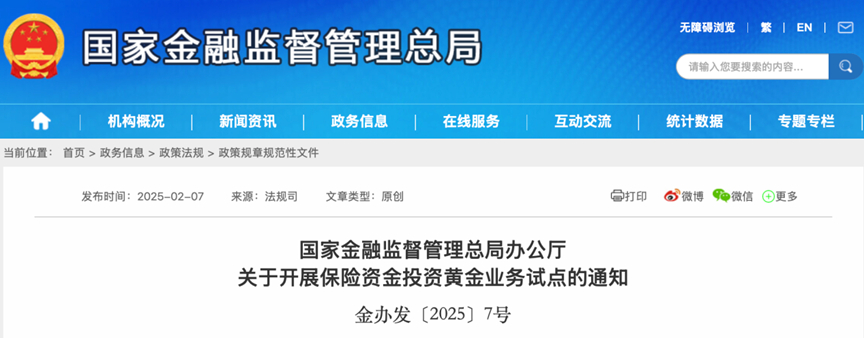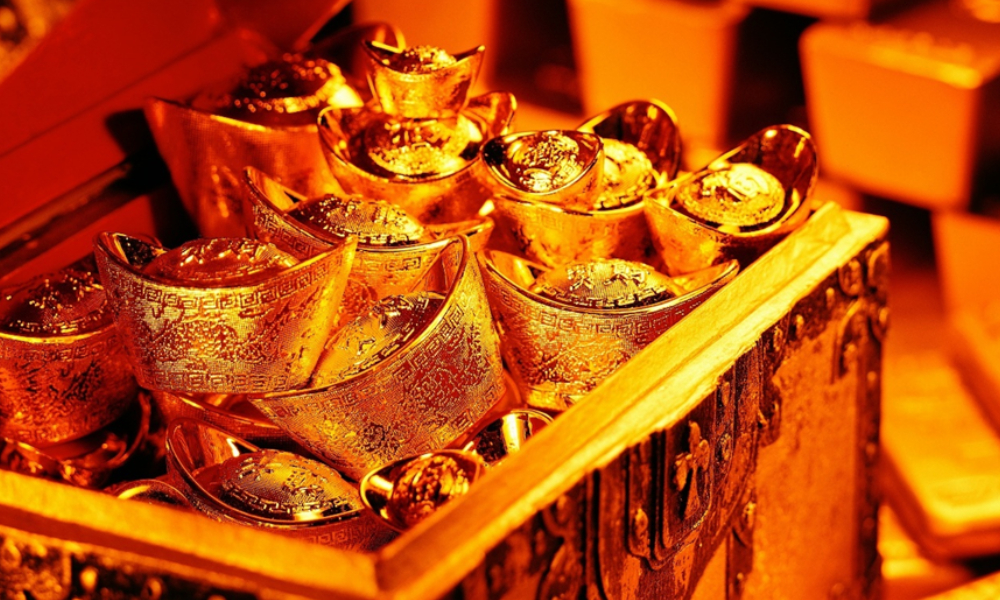China’s gold market is bracing for a potential shake-up. Liang Weizhang analyses the implications of a bold move: the entry of US$25 billion in Chinese insurance funds, questioning if this marks the start of a gradual revolution in the gold industry.
On 7 February 2025, China’s National Financial Regulatory Administration issued the “Pilot Notice on Insurance Fund Investment in Gold Business” (hereinafter referred to as the “Notice”), allowing ten large insurance companies to participate in gold investment and leasing through the Shanghai Gold Exchange. From an industry perspective, the ripple effects of this change on China’s and even the international gold and jewellery sectors remain to be fully seen, but unquestionably, the entry of Chinese insurance funds injects new vitality into the gold market.

Major Global Economies Generally Permit Insurance Capital in the Gold Market Under Strict Regulation
Internationally, major economies like the United States, the European Union, and the United Kingdom generally allow insurance capital to enter the gold market, albeit under stringent regulatory frameworks and risk management requirements. Insurance companies utilise derivatives, diversify trading structures, and engage in gold leasing to gain exposure to the gold market, thereby diversifying investment risks and hedging against inflation, while achieving asset preservation and appreciation. However, they are simultaneously constrained by rigorous internal risk management and regulatory requirements. Regulatory bodies typically limit the proportion of gold investments to a minimal level (around 1% or less of total assets) to ensure liquidity and stability. This approach reflects the regulatory philosophy and measures taken to balance asset diversification with the prevention of financial risks, making the participation of insurance capital in the gold market a relatively common yet controlled phenomenon.
Insurance Funds Entering the Market: A “Booster” or a “Stabiliser” for Gold Prices?
Jewellery industry stakeholders are primarily concerned about the impact of insurance funds on gold prices, fearing that large-scale capital inflows might further drive up prices, raising the consumption threshold for gold jewellery. However, the author believes that the entry of Chinese insurance funds into the gold trading market will have a limited impact on pushing gold prices higher. On the contrary, it may help Chinese consumers build new price confidence, which could benefit gold jewellery consumption.
Gold price fluctuations are still primarily driven by macroeconomic factors such as global capital market risk sentiment, monetary policy adjustments, geopolitical events, and inflation expectations. The influence of insurance funds on gold prices largely depends on the scale and manner of their investments. The “Notice” stipulates that the proportion of gold investment by insurance companies must not exceed 1% of their total assets. According to incomplete statistics from annual reports, the combined total assets of the ten pilot insurance companies reached approximately RMB 17.9 trillion by the end of 2023. This suggests that the maximum capital inflow into the gold market during the pilot phase is about RMB 179 billion (approximately US$25 billion). Compared to the global gold market’s daily trading volume, which amounts to several hundred billion US dollars, this scale remains relatively limited. In the context of the Chinese market, while it superficially exceeds the current daily trading volume of the Shanghai Gold Exchange, the investment purpose of “medium- to long-term asset allocation” and restrictions on speculative arbitrage mean this new capital is unlikely to flood into the gold market all at once. Furthermore, insurance companies are restricted to investing in contracts on the Shanghai Gold Exchange, including physical gold, deferred delivery contracts, and swap contracts, meaning their trading activities are primarily concentrated within the domestic market. Thus, the long-term investment and large-scale capital inflows from Chinese insurance funds may enhance domestic market liquidity and depth, offering more trading opportunities and risk management tools to participants. The policy’s direct impact on both Chinese and international gold prices is expected to be limited.
In the gold jewellery sector, gold consumption is closely linked to gold prices. China is one of the world’s largest gold jewellery markets. The new policy may help the consumer market establish a new round of price recognition, easing the cost pressures on production enterprises and boosting purchasing confidence, potentially revitalising the gold jewellery and gold-inlaid jewellery markets.
Expansion of Gold Leasing: Reducing Costs and Enhancing Efficiency for China’s Gold and Jewellery Industry
Gold leasing refers to the practice where gold holders (such as banks, insurance companies, or financial institutions) lend gold to enterprises that require physical gold (such as jewellers and manufacturers). The borrowers pay interest and management fees and return the equivalent amount of gold or settle at market price upon contract maturity. Currently, gold leasing in China has seen initial development. On 9 January, 2023, the People’s Bank of China implemented the “Interim Measures for the Administration of Gold Leasing Business,” allowing deposit-taking financial institutions to lend gold to enterprises that produce or require gold in their operations. In the practical operations of the gold and jewellery industry, gold leasing is characterised by large amounts, low thresholds, and high efficiency, making it particularly suitable for wholesalers with physical showrooms, manufacturers, and other gold enterprises. The gold leasing model eliminates the need for cash purchases of gold, significantly reducing the scale of working capital and alleviating financial pressure on enterprises. Additionally, gold leasing can help enterprises hedge against gold price fluctuations and allocate more funds to design and marketing, enhancing market competitiveness.
According to the “Notice”, the pilot policy allows insurance funds to engage in gold leasing business through the Shanghai Gold Exchange, with financial institutions as counterparties. Although jewellery enterprises cannot directly lease gold from insurance companies, financial institutions may act as intermediaries, reallocating leased gold to jewellery enterprises in accordance with the “Interim Measures for the Administration of Gold Leasing Business.” According to a 2022 report by China Gold News, industry insiders estimate that China’s gold leasing business is valued at approximately RMB 200-300 billion. Although the market is still relatively small, the new policy’s positive impact on gold market liquidity undoubtedly broadens the channels for gold leasing for gold jewellery production and sales enterprises, helping further reduce operational costs. The scope and participants of the gold leasing market are expected to expand, particularly in China’s rapidly growing e-commerce sector. The massive transaction volumes, rapid transaction cycles, mature supply chain loops, and relatively convenient regulatory conditions provide new application spaces for the expanding gold leasing business.
Innovation in Technology and Market: The Inevitable Path for Gold and Jewellery Enterprises
In the author’s view, the policy introduced by China’s financial regulatory authorities allowing insurance funds to enter the gold market is a further affirmation of gold’s role as a hedging asset and an asset allocation tool. This may also be part of China’s broader strategic considerations in the realms of finance, currency, and foreign exchange amidst increasing global economic uncertainties. For the gold and jewellery industry, particularly in major gold manufacturing and consumption countries like China and India, this may be interpreted as a signal: it is unrealistic to expect gold prices to return to previous levels in the short to medium term; innovation is the only path to survival and development amidst complex economic environments and intense market competition.
High gold prices have a noticeable suppressive effect on the demand for traditional gold jewellery, especially in terms of the weight of physical gold jewellery consumed. In 2024, international gold prices rose by nearly 23%(YoY), while China’s gold jewellery consumption fell by 24.69% (according to data from the China Gold Association). To cope with the cost increases and consumption challenges brought about by high gold prices, Chinese gold jewellery production enterprises have been continuously innovating in craftsmanship and design in recent years. One of the most significant innovations has been the development of hard gold technologies, including 3D hard gold, 5D hard gold, and 5G gold. These technologies alter the molecular structure of gold through electroforming processes, significantly increasing hardness (e.g., 3D hard gold can be four times harder than traditional pure gold), while reducing product weight. This results in lighter, more three-dimensional jewellery suitable for complex shapes and fashionable designs, which are highly favoured by young consumers. Moreover, live-streaming e-commerce is rapidly developing both in China and in major international consumer markets, driving the rapid growth of lightweight gold jewellery consumption. This trend also forces continuous innovation in product craftsmanship and design.
From a market perspective, in the context of high global gold prices, gold and jewellery enterprises must comprehensively innovate their market strategies to maintain competitiveness in a volatile market. In addition to adjusting product strategies, they must also focus on asset diversification and innovation in trading methods. Companies could consider strengthening their gold financial capabilities, viewing gold as an investment product, and collaborating with asset management companies to develop asset allocation products based on gold prices. Furthermore, in terms of branding strategies, building brand strength should become a key competitive factor in the market. By reinforcing brand development and highlighting cultural connotations and unique value propositions, companies can enhance their products’ brand premium capabilities.
It is particularly worth mentioning the importance of embracing the global market, utilising global distribution channels, and extending their advantages to new key markets with strong demand. This is especially crucial for enterprises in gold and jewellery manufacturing hubs like China and India. These companies have mature supply chain systems and operational experience, innovative technologies, and advanced production equipment, allowing them to form supply chain and technological advantages in other markets, especially in highly competitive, high-gold-price environments. For Chinese gold and jewellery enterprises, whether in terms of products, technologies, equipment, or supply chains, “Going Global” might be a shortcut.
‘Gold Jewellery,’ ‘Gold Bars,’ and ‘Gold Finance’: The Gradual Revolution of the Gold Market
China’s decision to allow insurance capital into the gold market and to include gold in the asset allocation strategies of Chinese insurance companies will further promote gold’s role as a hedging asset and asset allocation tool. This move will increase the complexity and financialisation of the gold market, reflecting the globalisation and inclusiveness of China’s financial regulation, as well as the maturity of the country’s gold market infrastructure. When gold is no longer a dormant asset in a safe, nor merely jewellery adorning people, but also an active figure on financial ledgers, a revolution in the gold industry is quietly unfolding. The entry of insurance funds is laying the groundwork for profound changes in both the Chinese and global gold markets. The ultimate winners of this revolution will be those enterprises and market participants who can keenly capture opportunities for transformation and leverage these changes for growth.
About the Author:
Liang Weizhang, CEO of HubWis Jewellery Strategic Creations (Guangzhou) Co., Ltd., is a senior analyst and strategic researcher in the jewellery industry. He is the founding President of the Guangzhou Diamond Exchange and Vice Chairman of the Guangdong Gold Association. With nearly 30 years of experience in the diamond, gold, and jewellery sectors in China and internationally, Liang offers deep industry insight and a strong professional network. His company supports jewellery businesses with strategic consulting, industry advice, and access to global markets.


